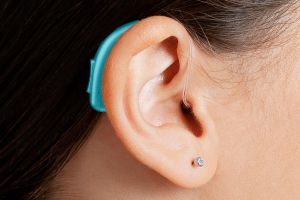Hearing Aids

About Hearing Aids:
A hearing aid is a small electronic device that a patient wear within or behind the ear. It makes some sounds louder (amplification) so that a person with hearing loss can listen, communicate, and participate more fully in daily activities. A hearing aid can help people hear more in both quiet and noisy situations.
A hearing aid has three basic parts: a microphone, amplifier, and speaker. The hearing aid receives sound through a microphone, which converts the sound waves to electrical signals and sends them to an amplifier. The amplifier increases the power of the signals and then sends them to the ear through a speaker.
Types of hearing aids:
Behind-the-ear (BTE) aids: in this type the aided case is connected to an earmold or an earpiece by a piece of clear tubing. This style is often chosen for young children and elderly with severe to profound hearing loss. The BTE aids are easy to be cleaned and handled, and are relatively sturdy.
Mini BTE aids: It also fits behind/on the ear, but is smaller. A very thin, almost invisible tube is used to connect the aid to the ear canal. Mini BTEs may have a comfortable ear piece for insertion (“open fit”). Mini BTE increase comfort, reduce feedback and address cosmetic concerns for many users.
In-the-ear (ITE) aids: All parts of the hearing aid are contained in a shell that fills in the outer part of the ear. The ITE aids are larger than the in-the-canal and completely-in-the-canal aids, and for some people may be easier to handle than smaller aids.
In-the-canal (ITC) aids and completely-in-the-canal (CIC) aids: These hearing aids are contained in tiny cases that fit partly or completely within the ear canal. These are the smallest hearing aids and offer cosmetic and some listening advantages.
